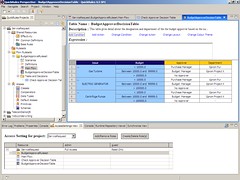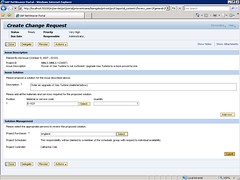I took a guide dog and a GPS, and ventured out onto the show floor to visit the NetWeaver Theater to see Wolfgang Hilpert discuss SAP NetWeaver BPM (that’s the official name) in more detail. Since this is my first real exposure to the product, I’m trying to get as many views of this as possible over the couple of days that I’m here, both to learn about the functionality of the product and hear the messaging and positioning around the product.
He started with similar material to Ginger Gatling’s presentation yesterday, looking at the key dimensions of business processes — structured versus non-structured, human-centric versus system-to-system, and business versus IT driver/focus — and how business processes (and the systems that support them) need to cover all of these dimensions. He also covered key process metamodel concepts — events, rules, data, roles, workflow/task and UI — and why they’re important.
He moved on to talk about the goals and value proposition of NetWeaver BPM, including model-driven development and business-IT collaboration. BPM is an integrated part of the NetWeaver composition environment, which makes it an easy transition for existing NetWeaver developers, although the Eclipse environment needs to provide a simplified perspective for business analysts who are involved in modeling.
There’s three parts to the BPM suite:
- Process Composer, which is the modeling environment;
- Process Server, where processes are executed;
- Process Desk, the user interface that is integrated into the portal environment and becomes part of the Universal Worklist.
 I have a huge amount of respect for anyone who talks and demos at the same time, and particularly so when they have a title to the north of VP; Hilpert falls into this category, and he fired up the demo and showed us what this actually looks like.
I have a huge amount of respect for anyone who talks and demos at the same time, and particularly so when they have a title to the north of VP; Hilpert falls into this category, and he fired up the demo and showed us what this actually looks like.
There’s a nice graphical interface for projects that shows a hierarchy of processes, user interfaces, business logic and services and how they interact, which makes it possible to detect dependencies of reusable components. As I mentioned yesterday, the process modeler is a pretty standard BPMN modeler, although I really like the context-sensitive mini-icons that are displayed around the selected object on the process model for creating the next connected object — nice usability feature. He also showed an interesting feature for creating a data/document artifact with automatic mapping from a process step to the artifact.
 The NetWeaver BRM integration is nice, since the rules and processes are designed within a common environment and can be linked up by dragging and dropping a rule onto a process condition instead of having to specify a web service call to the rules engine (although that could be what’s happening under the covers).
The NetWeaver BRM integration is nice, since the rules and processes are designed within a common environment and can be linked up by dragging and dropping a rule onto a process condition instead of having to specify a web service call to the rules engine (although that could be what’s happening under the covers).
We then moved on to the process participant’s user interface, using the NetWeaver Business Client portal. He filled out a simple (text fields only) form — although we didn’t see how this form was designed — which kicked off a business process that appears in the appropriate person’s Universal Worklist. There is a fairly standard task UI once the process is opened from a person’s inbox, which allows adding attachments (files or links), setting parameters using a variety of UI widgets (calendars, drop-down lists), viewing the current step in the graphical context of the entire process, and completing the work step.
 Update: found some screenshots from Ginger Gatling’s presentation deck and dropped them in.
Update: found some screenshots from Ginger Gatling’s presentation deck and dropped them in.
Moving away from the demo and back to presentation/discussion, he looked at the personas/roles within an enterprise that are involved in BPM, specifically the process architect (just on the IT side of the line), the business analyst (just on the business side of the line) and the business expert/SME (deep within business-land). Although this product release will address the needs of the process architect and business analyst, they are planning for other tools to expand business collaboration supporting the needs of the business analyst and the business expert. Part of that will be runtime visualization tools, such as dashboards, but it sounds like there’s also consideration of some design collaboration that will happen in the business area.
He went through the architecture that Gatling covered yesterday, and reinforced that the process integration layer is a rebranding of their current XI integration layer. The language around the future versions, where there will be a common process platform and SAP application core processes will be extended using the composition environment, is still a bit fuzzy, but we’re talking about things that will happen more than a year away.
There is nothing earth-shatteringly innovative about the SAP NetWeaver BPM suite: this is a perfectly ordinary BPMS. That’s not a criticism, especially considering that this is the first released version: it’s a reasonably full-functioned BPMS out of the box, and that’s all that SAP needs in order to compete within its existing customer base. They’re not trying to be the best BPMS on the market, they want to be the best BPMS for SAP customers.
